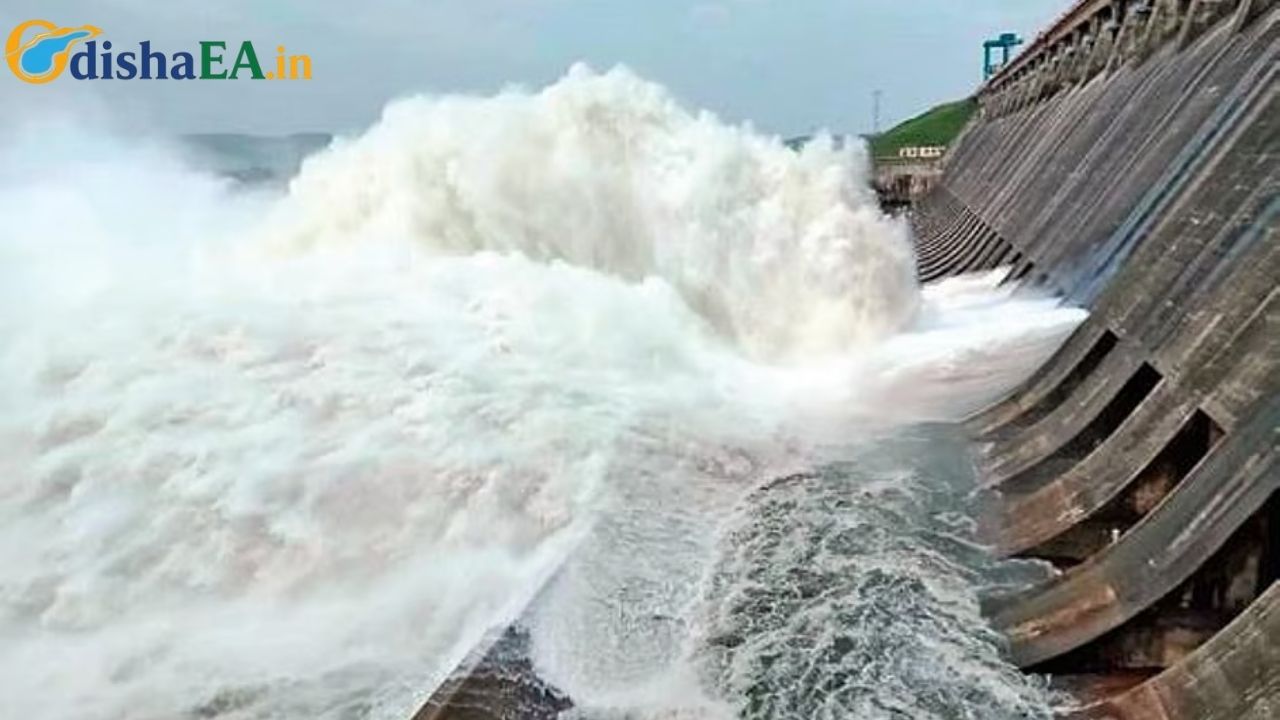The powerful forces of nature have once again reminded us of the crucial role dams play in managing water flow and protecting communities. Recently, heavy rains in the upper catchment areas of the Mahanadi River led to a significant rise in water levels at Odisha’s Hirakud Dam. To manage this surge, authorities made the important decision to open the sluice gates of the dam, releasing excess water into the river.

This action is a vital step to prevent overflow and potential flooding downstream, but it also comes with its own set of challenges and considerations. Whether you’re a local resident, a curious observer, or someone looking to understand more about how these massive engineering feats work, this article will break down the situation at the Hirakud Dam, what it means, and what steps can be taken to stay safe.
Heavy Rains Force Hirakud Dam to Open Sluice Gates
| Key Data | Details |
|---|---|
| Dam Name | Hirakud Dam, located near Sambalpur, Odisha |
| Water Level | 620.50 feet, as of Saturday morning |
| Maximum Capacity | 630 feet |
| Sluice Gates Opened | 4 (3 on left, 1 on right) |
| Inflow into Reservoir | 252,455 cusecs |
| Outflow from Reservoir | 31,525 cusecs |
| Current Forecast | Heavy rainfall expected till August 27 |
| Emergency Advisory | Issued to communities downstream for safety |
| Further Measures | Additional sluice gates may be opened if required |
| Official Website | Prameya News |
The Hirakud Dam is one of the largest earthen dams in the world, and it plays a crucial role in managing flood control, irrigation, and power generation. When heavy rains cause water levels to rise above the dam’s storage capacity, the sluice gates are opened to release excess water into the river. This helps reduce the risk of the dam overflowing and causing damage to nearby communities.
The opening of the sluice gates at the Hirakud Dam is a vital action taken by authorities to prevent catastrophic flooding downstream. While it’s a necessary step to protect communities, it also serves as a reminder of the delicate balance that must be maintained in flood control, water management, and disaster preparedness. By staying informed, taking safety precautions, and working together, we can mitigate the risks posed by such natural events.
What’s Happening at the Hirakud Dam?
The Hirakud Dam, a key piece of infrastructure in Odisha, is seeing one of its busiest times due to heavy rainfall in the upper catchment areas. This rainfall has significantly increased the water inflow into the dam, causing the water level to rise steadily. Currently, the dam stands at 620.50 feet, which is near its maximum capacity of 630 feet. To prevent any potential flooding and ensure the safety of surrounding areas, the authorities have opened four sluice gates—three on the left side and one on the right side of the dam.
This is not the first time the dam has been put to the test. It was constructed in the 1950s and has been a reliable means of managing water in the region ever since. However, as we continue to experience more extreme weather events due to changing climates, the operation of such dams becomes even more critical.
Water Discharge Process
The process of releasing water from the Hirakud Dam is done through sluice gates, which are essentially large openings in the dam structure that allow water to flow out when needed. These gates are controlled carefully, with authorities monitoring the water levels closely. As of the latest update, the outflow of water is at 31,525 cusecs, while the inflow has been recorded at over 252,000 cusecs.
To put that into perspective, one cusec is roughly equivalent to the flow of 28.3 liters of water per second. Therefore, the inflow of over 250,000 cusecs means a massive volume of water is entering the dam. This makes controlling and releasing the water a delicate operation, as failure to do so properly can result in flooding downstream.
Why Is This Happening Now?
It’s not just a random event—there’s a reason why we are seeing heavy rainfall and high water levels at this time. The India Meteorological Department (IMD) has attributed the ongoing rains to a low-pressure area over the Bay of Bengal. This low-pressure system is expected to continue bringing heavy rainfall to the region until at least August 27. This means that the inflow into the Hirakud Dam will likely remain high for the foreseeable future, and authorities will continue to monitor the situation carefully.
The dam’s role in flood management is especially crucial in this region, as the Mahanadi River basin is one of the most flood-prone areas in India. The impact of opening sluice gates at this time is being carefully assessed, but it is necessary to protect the communities living downstream.
How Does This Affect Local Communities?
While the dam helps control floods, the opening of the sluice gates creates potential risks for downstream communities. The immediate impact is felt by villagers and towns near the Mahanadi River, who are now under alert. The release of such a large amount of water can cause the river to swell, and those living near the banks are advised to take safety precautions.
Authorities have issued advisories urging people not to venture into the river, as the water flow will increase significantly. In some cases, evacuation orders may be issued for those in low-lying areas at risk of flooding. The district administration is working with local communities to ensure that residents are well-informed and that emergency plans are in place should the situation escalate.
Practical Safety Tips for Local Residents
If you live in an area affected by the rising water levels, here are some practical safety tips to help you stay safe:
1. Stay Informed:
Keep an eye on local news and government advisories. The situation is evolving, and you’ll want to stay updated on any emergency measures or evacuations.
2. Move to Higher Ground:
If you live in a low-lying area near the river, consider moving to higher ground until the water level recedes. Flooding can occur quickly, and it’s best to be prepared.
3. Prepare an Emergency Kit:
Have essentials like food, water, medications, and important documents packed and ready to go. This is a good habit for any weather-related emergency.
4. Avoid Waterways:
Never attempt to cross fast-moving or flooded rivers. Even small amounts of moving water can knock you off your feet and cause serious harm.
5. Help Your Neighbors:
Check on elderly or disabled neighbors to ensure they have what they need. Sometimes, during a flood event, the most vulnerable populations can be the hardest hit.
What Else Can We Learn from the Hirakud Dam Incident?
This situation at the Hirakud Dam provides an opportunity to reflect on the broader implications of our water management systems. Dams like Hirakud are essential for controlling floods and managing water supplies for irrigation and power generation, but they also come with challenges. Over-reliance on a single system to control large amounts of water can be risky, especially as climate change brings more unpredictable weather patterns.
The Hirakud Dam is not just about releasing water to prevent floods—it’s about managing the delicate balance between maintaining safety for communities and optimizing the resources that the dam provides. The risk of heavy rainfall, coupled with the aging infrastructure of many dams worldwide, emphasizes the need for continuous improvements in flood management systems and infrastructure development.
Landslide Blocks Damanjodi–Narayanpatna Route in Koraput After Torrential Rain
Floods Devastate Kendrapara Agriculture: Paddy Saplings, Vegetable Crops Damaged
Odisha’s Weather Update: Fresh Low-Pressure System to Bring Additional Downpours
FAQs
1. How does the release of water from the dam affect people living downstream?
The release of water from the dam increases the flow of the Mahanadi River, which can lead to flooding in nearby areas. It is crucial for residents in these areas to stay informed and follow evacuation orders if necessary.
2. What is a sluice gate and how does it work?
A sluice gate is a large opening in a dam that allows water to flow out. The gates are controlled to regulate water release based on the dam’s water levels, ensuring the structure remains stable.
3. What should I do if I live in a flood-prone area near the river?
Stay informed through local authorities, move to higher ground if necessary, and have an emergency kit prepared with essential items.
4. Why is this happening now?
Heavy rainfall in the upper catchment areas has led to a rise in water levels at the dam, prompting authorities to release excess water to prevent flooding.
5. How can I stay safe during heavy rains and potential flooding?
Follow local news updates, avoid riverbanks, and make sure to prepare an emergency kit with essentials in case of evacuation.





